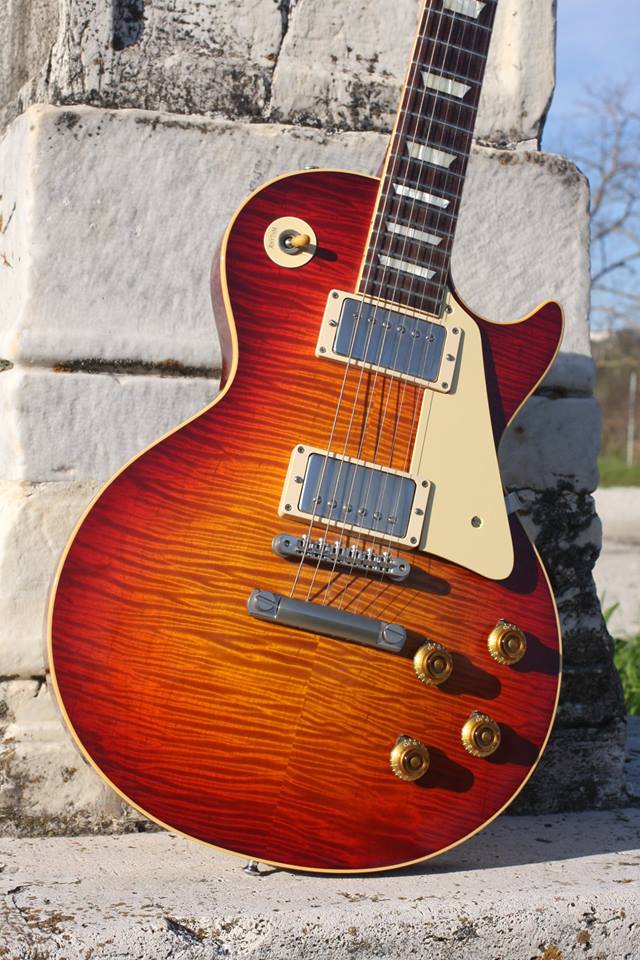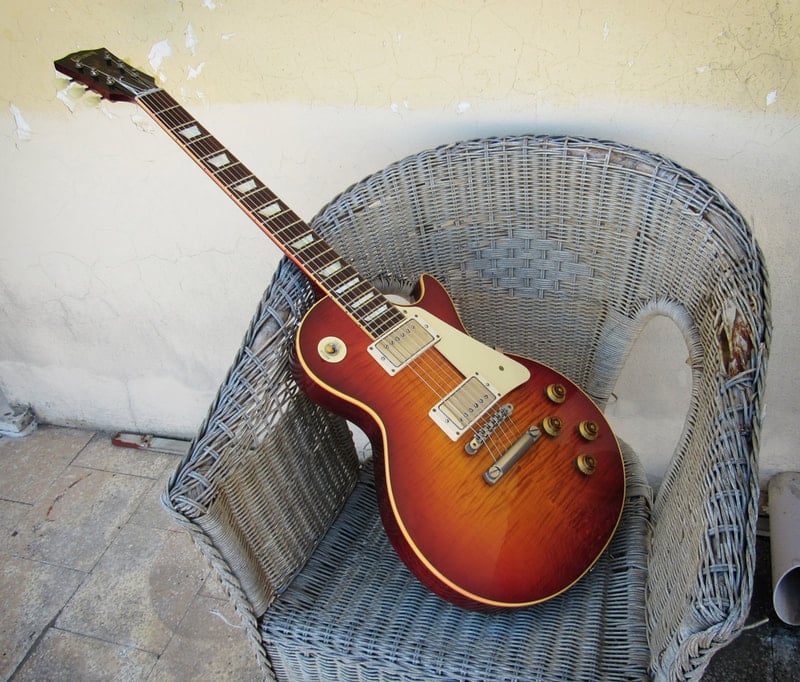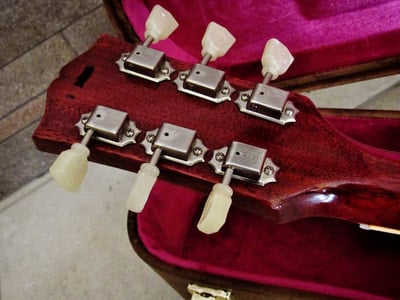With the launch of its programme “Historic,” beginning in 1993, Gibson tried to capture the magic of its best years by reproducing the “Les Paul” model as it was made between 1958 and 1960. It wasn’t a simple feat because the Kalamazoo company was a far cry from the guitars of those years. However, year after year, the Custom Shop got closer and closer to the old Les Paul guitars, thanks to an accurate and thorough analysis of the original ones.
Therefore, if you are an avid fan of Les Paul vintage guitars it’s very difficult not to fall in love with this guitar. It’s true, there are instruments, purely from a guitar construction point of view, that are more modern. But, if you are looking for the sounds of Jimmy Page, Paul Kossoff, the first Eric Clapton or Billy Gibbons, you cannot do without a Les Paul. The True Historic guitars are the expression of maximum level construction that Gibson can offer, giving everyone the “impression” of holding the late 50s Les Paul guitars.
All the improvements made in 2013 are considered an essential step by many guitarists and a useless waste of resources by many others, above all by those who own the old “top of the line.” However, although Gibson improved the old Historic project with this series, the considerable difference in price between the Historic Standard and the True Historic guitars is inexplicable.
What is certain is that Gibson has learned to improve its reissues year after year, above all, thanks to the use of new construction techniques and materials.
For example, in 2013 Gibson began using a fingerboard made with a piece of Indian rosewood on these guitars, while until 2012, a lot of reissues had laminated fingerboard with. In the same year the method of inserting the truss rod was also changed. The new technique meant that the sleeve used in recent years to reduce the risk of resonance, wasn’t needed. The installation of the new sleeveless truss rod, adhering to the specifications of the original doesn’t, in fact, give that type of problem.
In 2013 Gibson returned to using hide glues, which had long been replaced by synthetic ones to speed up construction for its True Historic necks. In 2014, use of hide glues was firstly extended to the fingerboards and then, in 2015, also to the body of all the new True Historic guitars, as was normally done by Gibson in the '50s.
Therefore, if you are an avid fan of Les Paul vintage guitars it’s very difficult not to fall in love with this guitar. It’s true, there are instruments, purely from a guitar construction point of view, that are more modern. But, if you are looking for the sounds of Jimmy Page, Paul Kossoff, the first Eric Clapton or Billy Gibbons, you cannot do without a Les Paul. The True Historic guitars are the expression of maximum level construction that Gibson can offer, giving everyone the “impression” of holding the late 50s Les Paul guitars.
All the improvements made in 2013 are considered an essential step by many guitarists and a useless waste of resources by many others, above all by those who own the old “top of the line.” However, although Gibson improved the old Historic project with this series, the considerable difference in price between the Historic Standard and the True Historic guitars is inexplicable.
What is certain is that Gibson has learned to improve its reissues year after year, above all, thanks to the use of new construction techniques and materials.
For example, in 2013 Gibson began using a fingerboard made with a piece of Indian rosewood on these guitars, while until 2012, a lot of reissues had laminated fingerboard with. In the same year the method of inserting the truss rod was also changed. The new technique meant that the sleeve used in recent years to reduce the risk of resonance, wasn’t needed. The installation of the new sleeveless truss rod, adhering to the specifications of the original doesn’t, in fact, give that type of problem.
In 2013 Gibson returned to using hide glues, which had long been replaced by synthetic ones to speed up construction for its True Historic necks. In 2014, use of hide glues was firstly extended to the fingerboards and then, in 2015, also to the body of all the new True Historic guitars, as was normally done by Gibson in the '50s.
Other innovations in 2015 include the double-carving and hand polishing: for the top, to give it a vintage look and for the handle to give it a better outline. There is the preconceived idea that all Les Paul vintage guitars are enormous. It isn’t quite like that. The 59’s neck is big enough to feel good in your hands and guarantee the ‘Les Paul Sound,’ but the rounded shape on the sides makes it very comfortable. However, they can each vary a little so it’s always better to try out the guitar before purchasing it.
From 2015 the headstock is also different. It now has a 17° inclination, it’s slightly rounded at the edges and its veneer is finer. On the front side, the Gibson pearly yellow logo stands out.
The True Historic’s body is distinguished by its lightness (mine weighs 3.9 kg) it is non-chambered and non-weight-relieved and is joined to the neck with the long tenon system.
Its finish isn’t just achieved by spraying a light layer of nitro (from 2015 it is finer with respect to previous years), but it was also hand crafted in a second step. Its color, Vintage Cherry Sunburst, is very attractive and highlights the extremely regular lines on its maple top. Aniline, which hadn't been used since the '60s by Gibson due to its sensitivity to ultraviolet rays, as can be seen on the old ‘Bursts,’ was used for the back and the neck. Unfortunately, it tended to penetrate the binding of the first True Historic guitars made, modifying them to a reddish color.
The new pickups, introduced in 2013, were called Custom Bucker and are Gibson’s latest development in getting nearer to the old PAF. They are similar to the Burstbucker but in Alnico III. Regarding electronics, True Historic Les Paul guitars are equipped with 500k CTS potentiometers and Bumblebee capacitors. It all seems perfect. However, some people dispute the angle of the pickup’s grill which is still too pronounced with respect to the PAFs. But, it’s a question of aesthetics also in this case.
On the subject of aesthetics, Gibson used new plastics on these guitars that are close to the vintage ones in composition, look and position on the guitar. The bridge posts are in brass and the thumbwheels in steel.
The result is a guitar which has surprising clarity and dynamics as well as sound scope that covers all the frequencies. It is rich in the medium range, but without exaggerating, brilliant and without a muffle bass. The sound cleans itself up harmoniously if the volume knob is turned off, reminding us of classic notes used in jazz.
When played without the amp it has a clear sound with few bass frequencies. When attached to a Marshall it becomes a real rock machine!
From 2015 the headstock is also different. It now has a 17° inclination, it’s slightly rounded at the edges and its veneer is finer. On the front side, the Gibson pearly yellow logo stands out.
The True Historic’s body is distinguished by its lightness (mine weighs 3.9 kg) it is non-chambered and non-weight-relieved and is joined to the neck with the long tenon system.
Its finish isn’t just achieved by spraying a light layer of nitro (from 2015 it is finer with respect to previous years), but it was also hand crafted in a second step. Its color, Vintage Cherry Sunburst, is very attractive and highlights the extremely regular lines on its maple top. Aniline, which hadn't been used since the '60s by Gibson due to its sensitivity to ultraviolet rays, as can be seen on the old ‘Bursts,’ was used for the back and the neck. Unfortunately, it tended to penetrate the binding of the first True Historic guitars made, modifying them to a reddish color.
The new pickups, introduced in 2013, were called Custom Bucker and are Gibson’s latest development in getting nearer to the old PAF. They are similar to the Burstbucker but in Alnico III. Regarding electronics, True Historic Les Paul guitars are equipped with 500k CTS potentiometers and Bumblebee capacitors. It all seems perfect. However, some people dispute the angle of the pickup’s grill which is still too pronounced with respect to the PAFs. But, it’s a question of aesthetics also in this case.
On the subject of aesthetics, Gibson used new plastics on these guitars that are close to the vintage ones in composition, look and position on the guitar. The bridge posts are in brass and the thumbwheels in steel.
The result is a guitar which has surprising clarity and dynamics as well as sound scope that covers all the frequencies. It is rich in the medium range, but without exaggerating, brilliant and without a muffle bass. The sound cleans itself up harmoniously if the volume knob is turned off, reminding us of classic notes used in jazz.
When played without the amp it has a clear sound with few bass frequencies. When attached to a Marshall it becomes a real rock machine!






















